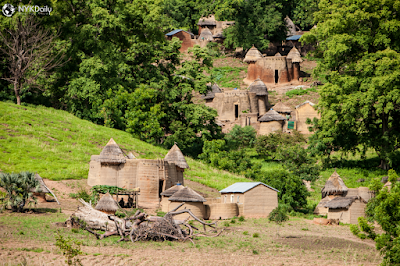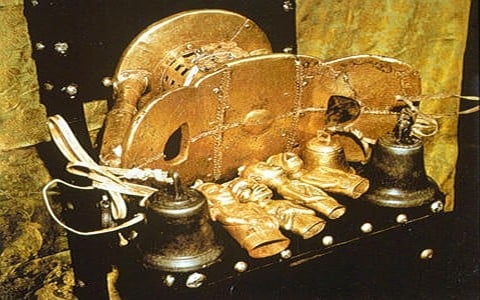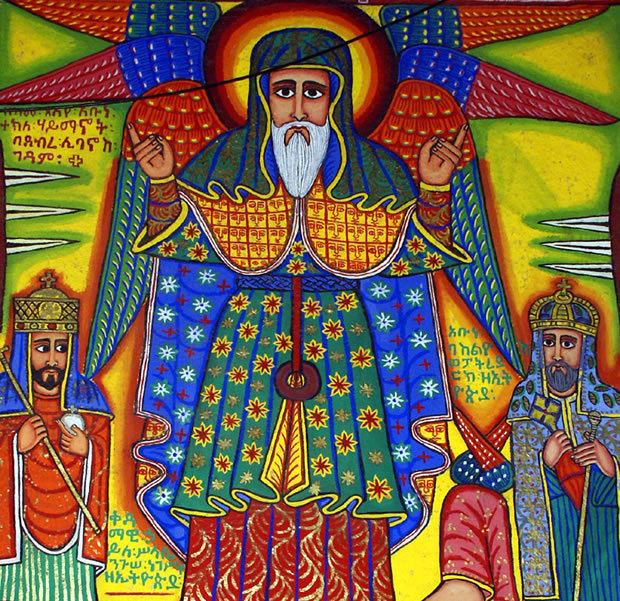| A road on the rural outskirts of Mampong, a town with deep personal connections to both Konadu and Osei Kwame |
From Aksum to Zimbabwe, Casablanca to Cape Town, learn about the fascinating civilizations and stories of Africa on the first dedicated Pre-Colonial African history podcast.
| A road on the rural outskirts of Mampong, a town with deep personal connections to both Konadu and Osei Kwame |
 |
| In the modern era, Abura has merged with the nearby town of Dunkwa, and is a small town in South-Central Ghana. |
The period that lasted from the late 18th Century until the mid 19th Century is often labelled the Age of Revolutions. Visualizing this time period provokes images of the various revolutions of Europe and the Americas, and the likeness of George Washington, Simon Bolivar, Maximillian Robespierre.
In the West African Empire of Ashanti, the late 18th Century was also a time of revolution. In 1763, a crowd of bureaucrats, nobles, and common people alike convened in the empire's capital of Kumasi. There, they declared the impeachment of the current Asantehene, the elderly and unpopular Kusi Obodom. The crowd had many bones to pick with Obodom: his cession of power to provincial governors, his failed military record, and the general moribundity of his rule. In his place, the assembled citizens elected the energetic reformer prince, Osei Kwadwo.
 |
| Despite his unpopularity, Kusi Obodom was still given a traditional black funerary stool. His was kept separately from the other kings' stools though, and is thus not pictured here. |
Due to the many radical reforms implemented during his rule, as well as the fact that he was the first elected asantehene, the period of Kwadwo's rule would go down in history as the Kwadwoan Revolution. And revolutionary it was. By the time Kwadwo's reign ended, every aspect of Ashanti government had been radically transformed. While the asantehene had never been a true autocrat in practice, Kwadwo's reforms would significantly limit executive power, making the Ashanti Empire into a true constitutional monarchy.
The first area of government which Kwadwo reformed was the Kotoko, the cabinet of local kings that advised the asantehene on matters of state. The fact that local kings served on the Kotoko was vital for state stability, but was also somewhat of a relic of Osei Tutu's era. Promoting unity within the Ashanti state was still important, but the loyalty of the kings of Juaben, Bekwai, and Mampong was no longer the pressing issue it once was. In fact, having local kings in this important administrative system caused more trouble than it was worth. During the recent failed war against the Dahomey, the potential dangers of including unqualified nobles in government was made clear. Odankua, a constituent king on the Kotoko, performed poorly during the war, and his unwise decision making contributed to the Ashanti's defeat. Kwadwo did not abolish the inclusion of local kings on the Kotoko, but rather limited their role. In addition to the three kings, new positions filled by professional bureaucrats were added to the council. These included a designated minister of war, minister of finance, and governor of Kumasi. These positions were not hereditary, but rather appointed based on merit. Kwadwo also shook up the bureaucracy more generally, abolishing hereditary bureaucratic offices and replacing them with meritocratic positions.
However, the most pressing issue for Kwadwo to reform was the balance of power within the Ashanti government. For the last several decades, conflicts between the Nsafohene (national bureaucrats from Kumasi), and amanhene (provincial governors) had contributed to instability within the Ashanti state. At its worst, this feud had contributed to the civil war that brought Kusi Obodom to power. To reduce the potential instability of these conflicts, Kwadwo decided to create an alternative means for these two groups to settle disputes. He created a parliamentary body called the Asantemanhyiamu, or "Meeting of the Ashanti Nation." This parliament was attended by both Nsafohenes and Amanhenes, as well as the asantehene himself and the members of the Kotoko. The creation of the Asantemanhyiamu allowed the Amanhene and Nsafohene to settle their disputes through deliberation and argumentation, rather than civil war.
 |
| While they now lack any formal legal power, the traditional bureaucrats, amanhene, and local nobility continue to meet at the Asantemanhyiamu (now held at the Manhyia Palace, Kumasi) |
 |
| Today, Atakpame is a tranquil town in the Togo countryside. In 1763, it was the site of a major battle. |
This episode begins with the collapse of the Ashanti government. As will continue to be a major factor throughout this series, power disputes between the newly created Nsafohene (government bureaucrats) and Amanhene (local governors) came to a head around the end of Opoku Ware's time on the throne. His precarious efforts to balance power between these two institutions resulted in him receiving the favor of neither, and a 1748 coup in Kumasi forced the asantehene to flee from the capital city to Juaben.
When Opoku Ware died in 1750, the tensions between the nsafohene and amanhene boiled over into an outright civil war. The nsafohene supported Dako, Opoku Ware's assigned heir who promised to continue his uncle's policy of centralizing the government's power. The amanhene sided with Kusi Obodom, a half-blind, elderly, and alcoholic ruler who sought to allow more self-government to the amanhene. While the details of the war are lost, after seven years of hard fighting, the amanhenes' faction came out on top.
 |
| Ghana continues to have traditional amanhene today, who act as local traditional leaders. Pictured here is the amanhene of Gyadam, a town in Ghana's eastern region. |
In this episode, we chart the life of Opoku Ware, a man who nobody expected to become the asantehene. He was not among the first in line to become the next king of the Ashanti, nor was he the commander of a strong military. In fact, calling him a man at the start of his reign is a bit misleading, as most estimates believe him to have been a teenager when he was first enstooled. Despite his young age, however, Opoku Ware would not only prove to be a surprisingly successful ruler, but would in fact rescue the Ashanti Empire from the brink of destruction.
 |
| James C. Lewis' Take on Opoku Ware |
With peace restored among the Ashanti, Opoku Ware and the Ashanti army began the long and arduous journey to dealing with their many external foes. The Akyem signed a peace treaty with the Ashanti, while the Aowin, Wasa, Bono, and Gonja were defeated with force of arms. The Akwamu were subdued through surreptitious means. Opoku Ware offered military support to a faction in an ongoing Akwamu succession crisis, reviving the alliance between the Ashanti and the victorious faction. A =fter the Ashanti intervention in the Akwamu succession crisis, many of the Akwamu aligned with the defeated faction were sold into slavery to the Danish at Accra. Finally Opoku Ware threatened the king of Dagbon into becoming a tributary of the Ashanti, an offer which the Dagomba king reluctantly accepted.
 |
| After being sold to the Danish, Akwamu slaves staged a nearly successful revolt on the Caribbean island of St. Thomas |
Hope you enjoy the latest episode of the History of Africa podcast. This episode, we picked up right where we left off last time. Osei Tutu is a fugitive prince who has just returned to his hometown of Kumasi, with his Denkyira former captors too busy with wars in the South to pursue him north. However, a lull in the violence in the Denkyira's south allowed them to turn their attention back to the North, and finally focus on recapturing the renegade prince in Kumasi.
However, Osei Tutu was not in a capitulary mood. He had spent the last several years building a powerful army, one which used modern organization, tactics, and bureaucratization. This new force, he hoped, would finally be enough to equal the Denkyira's strength.
 |
| The famous Ashanti golden stool |
 |
| Today, Feyiase is a small town in Ghana's Ashanti region. In 1701 it was the site of a dramatic clash between Ashanti and Denkyira armies. |
 |
| French Illustration of an Ashanti Scout (1884) |
I hope you enjoyed this week's episode of the History of Africa podcast. This episode focused on the reorganization of the Ashanti army that took place after Osei Tutu's return in 1695. As of his return, the Ashanti people were still disunited. While the multiple Ashanti kingdoms fought as allies against their common enemy the Dormaa, they were still esssentially multiple armies under one banner. However, Osei Tutu sought to transform this status quo. In order to prepare for the inevitable war against the Denkyira, the King of Kumasi, Osei Tutu, ordered the reorganization of the Ashanti's current cobbled together army of local militias into a single, unified force of professional soldiers. Additionally, Osei Tutu sought to educate this new army in modern Akan tactics, replacing the old manner of traditional battle.
 |
| Fante soldiers, which practiced similar modern, firearm dependent tactics to the Denkyira or Akwamu. |
These new tactics would be necessary if the Ashanti were going to stand up to the Denkyira. Like the other states in the southern region of Ghana, the Denkyira had adopted modern tactics and fully integrated firearm use into their wartime strategies. If the Ashanti tried to face the modern, gun-wielding tactics of the Denkyira with traditional, sword-wielding Akan tactics, they would be crushed.
To teach his army in this modern way of warfare, Osei Tutu conscripted the Akwamu soldiers who had accompanied him on his return to Kumasi. Like the Denkyira, the Akwamu had long adapted modern firearms focused tactics and had used them in their own successful wars of conquest.
The Ashanti army was drilled in the Akwamu strategic doctrine. Akwamu strategy hinged on encircling the enemy. The army was divided into several components. A scouting regiment tracked enemy forces, sabotaged their paths, and launched guerrilla style sniper attacks. The forward guard, composed of the best trained members of the Ashanti army would fiercely attack the enemy, forcing the enemy into a static defensive position. The four wings would then move around the pinned enemy, attempting to encircle the enemy. The main body provided a manpower reserve for whichever part of the army needed reinforcements. Meanwhile, the rear guard of the army sat at the back of the force, protecting against encirclement. Officers and nobility were protected by a specialized group of bodyguards meant to protect these critical people from being hurt or killed in a potential defeat. Finally, the army was accompanied by a horde of medics, engineers, supply transporters, and foragers, meant to support the army in non-combat matters.
While the Ashanti were still new to this type of warfare were far from perfectly implementing this doctrine. Despite this, the Ashanti put this new style of warfare to great use against the Dormaa, decisively defeating their eastern rival when the Dormaa tried to invade Kumasi. But, compared to the coming threat, the Dormaa were small change. During our next episode, we'll see how this new army fares against the centuries old hegemons of the Ghanaian forest region, the Denkyira.
 |
| The Eagles Talons: Akan symbol for the Oyoko Tribe, which claims the falcon as its sacred animal. |
| A kum tree, the species used by Anokye to test the soil of various locations. |
 |
| Oware, a strategy game similar to mancala, has been a mainstay Akan leisure hobby for centuries. |
I hope you enjoyed the latest episode of the History of Africa Podcast, this episode focusing on the rise of the Denkyira Empire, the state which dominated southern Ghana throughout the 16th and 17th centuries.
 | ||
|
The Denkyira profited immensely from their trade with the Europeans, receiving finished products, with firearms being the most crucial. In order to receive an edge on their neighbors, the Denkyira government began importing European firearms en masse. This strategy was effective and allowed the Denkyira to expand their territory along Ghana's coast, at least until their neighbors began similarly importing firearms and adapting their tactics for their use.  |
| Eventually, the Denkyira (and other Akan) did figure out how to manufacture firearms of their own, like this short barreled arquebus. |
 |
| The town of Obuasi was Denkyira's principal gold mine. |
 |
| One of the famous monolithic churches of Lalibela, built by the Zagwe Dynasty |
| The Queen Gudit Stele Field. Despite its name, the site's actual relationship to Gudit herself is tenuous. Photo Courtesy of Wolff Chronicles |
| A Mural from the Dega Istefanos Monastery on Ethiopia's Lake Tana. This monastery is sometimes attributed to the reign of Del Naod, but this is highly contested. Degna Djan is dead, and his sons, Anbasa Wedem and Del Naod, have begun a struggle for the throne. Or did they? As we dive into this episode, we examine the strange and confounding history behind the end of the Aksumite Empire |
Hey everyone, I hope you enjoyed the latest episode of the History of Africa podcast. This latest episode focuses on Degna Djan, one of the last kings of Aksum, and, somehow, one of the greatest kings in Aksumite history. During his rule, he oversaw an Aksumite renaissance, leading to the final period of Aksum as the hegemon of East Africa.
 |
| Lake Hayq, one of the likely locations of the Late Aksumite capital of Ku'bar |
 |
| Tekle Hayamanot, a prominent Ethiopian saint, abuna, and historian, depicted in a church mural |
Hello everyone, I hope you enjoyed the latest episode of the podcast. This one was admittedly a little weird because of the circumstances surrounding the history being discussed. The podcast generally tries to focus on history from a narrative perspective, telling the podcast as a linear story. I personally like this format because it makes the show more digestible, personable, and, frankly, entertaining. However, due to the fact that this episode focuses on a historiographic dark age in Aksumite history, writing in a narrative style for this episode was simply impossible. However, the era which encompassed around 600-880 AD, despite being a time with few surviving records, is a crucial era for understanding long-term trends affecting the Aksumite state, economy, and society during its waning years.
The general trend of the era in Aksum during this era was one of decentralization. Economically, the model of centralized cities as the basis of the Aksumite economy declined. Rather than the trade and sale of finished goods and exotic materials, the new Aksumite economy was dominated by subsistence farming of teff. Politically, the once autocratic power of the Aksumite negus was divided among the increasingly powerful Tewhahedo Church and local landowners.
 |
| A Village in the Dahlak Islands |
 |
| The City of Jeddah, captured and briefly occupied by Aksumite merchants in the 8th century, is now a major city in Saudi Arabia. However, by the end of the 10th century, the islands inhabitants had established a local power base strong enough to challenge both Arab and Aksumite domination, resulting in the creation of an independent sultanate on the archipelago. In a final effort to reassert their power, Aksumite merchants made a desperate campaign to capture the island of Socotra in the late 10th century. The initial invasion was a success, with the Aksumite state seemingly endorsing the invasion through the decision to ordain a new bishop on the island. However, less than a decade later, Al-Salt bin Malik, the ruler of Oman, decided to respond to this challenge of Omani trade power in the region. He sent a fleet which successfully dislodged the Aksumites from the island, ending Aksumite merchant power in the Arabian and Red Seas. |
 |
| A small version of a Somali woven ship, called a beden. |
| An early modern depiction of a larger Somali ship from a European atlas |